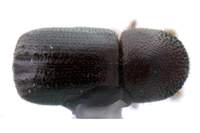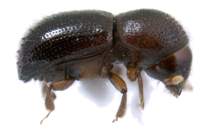Diagnosis
Main identification character: pronotal disc covered with asperities (in most Xyleborini, only frontal slope of pronotum asperate). Dark, stout species with densely punctured or granulate surface. Pronotum more rounded than in other Xyleborini, both from side view and top view. End of elytra very steeply rounded.
Distribution
In most temperate and tropical regions of the world.
Biology
Most species attacking smaller branches. Often occuring in aggregations of several conspecific galleries.
Taxonomy
Traditionally included any larger and bulkier xyleborine, especially with asperate pronotal disc (Wood & Bright, 1992). Species without pronotal asperities recently moved to Ambrosiophilus (Hulcr & Cognato, 2009), very large species with reduced protibial denticles moved to Immanus (Hulcr & Cognato, 2010)
Detailed description
Eyes shallowly emarginate, upper part smaller than lower part. Antennal club approximately circular, club type four (segment 1 small, second and third prominent on both sides), or five (all pubescent, sutures obscured). Segment 1 of club convex, small, its margin pubescent or carinate. Segment 2 visible on both sides of club, mostly soft, partly corneous. Segment 3 clearly visible on both sides of club. Segment 1 of antennal funicle shorter than pedicel, funicle 4-segmented, scapus regularly thick (not long and slender). Frons above epistoma rugged, coarsely punctured. Submentum slightly impressed, shaped as very narrow triangle. Anterior edge of pronotum with no conspicuous row of serrations (serrations on margin don't differ from those on pronotal slope). Pronotum from lateral view low and rounded (type 1), from dorsal view basic, short, parallel-sided, rounded frontally (type 2). Pronotal disc covered with asperities resembling those on frontal slope. Lateral edge of pronotum obliquely costate. Procoxae contiguous, prosternal posterocoxal process tall and pointed, or conical and slightly inflated. Tuft on pronotal basis associated with mesonotal mycangium absent, also setae on elytral bases associated with elytral mycangium absent. Scutellum flat, flush with elytra. Elytral bases straight, with oblique edge, elytral disc longer than declivity, flat or slightly convex, punctures on elytral disc in strial lines. Lateral profile of elytral declivity steep, especially towards apex, dorsal profile of elytral apex rounded, or broadened laterally. Elytral declivity with few setae or scales, not conspicuously pubescent. Posterolateral declivital costa ending in 7th interstriae. Inner part of declivity has no tubercles on interstria 1 (sutural), and several tubercles on interstriae 2, 3 and beyond. Striae and interstriae on upper part of declivity mostly flat, striae sometimes impressed or interstriae elevated. First interstriae parallel. Protibiae with evenly rounded edge. Posterior side of protibia flat, without granules. Protibial denticles large, distinctly longer than wide, their bases not enlarged, protibial margin rounded, between 6 and 8 protibial denticles present. Color reddish to black. Length 2.6-3.5 mm.


